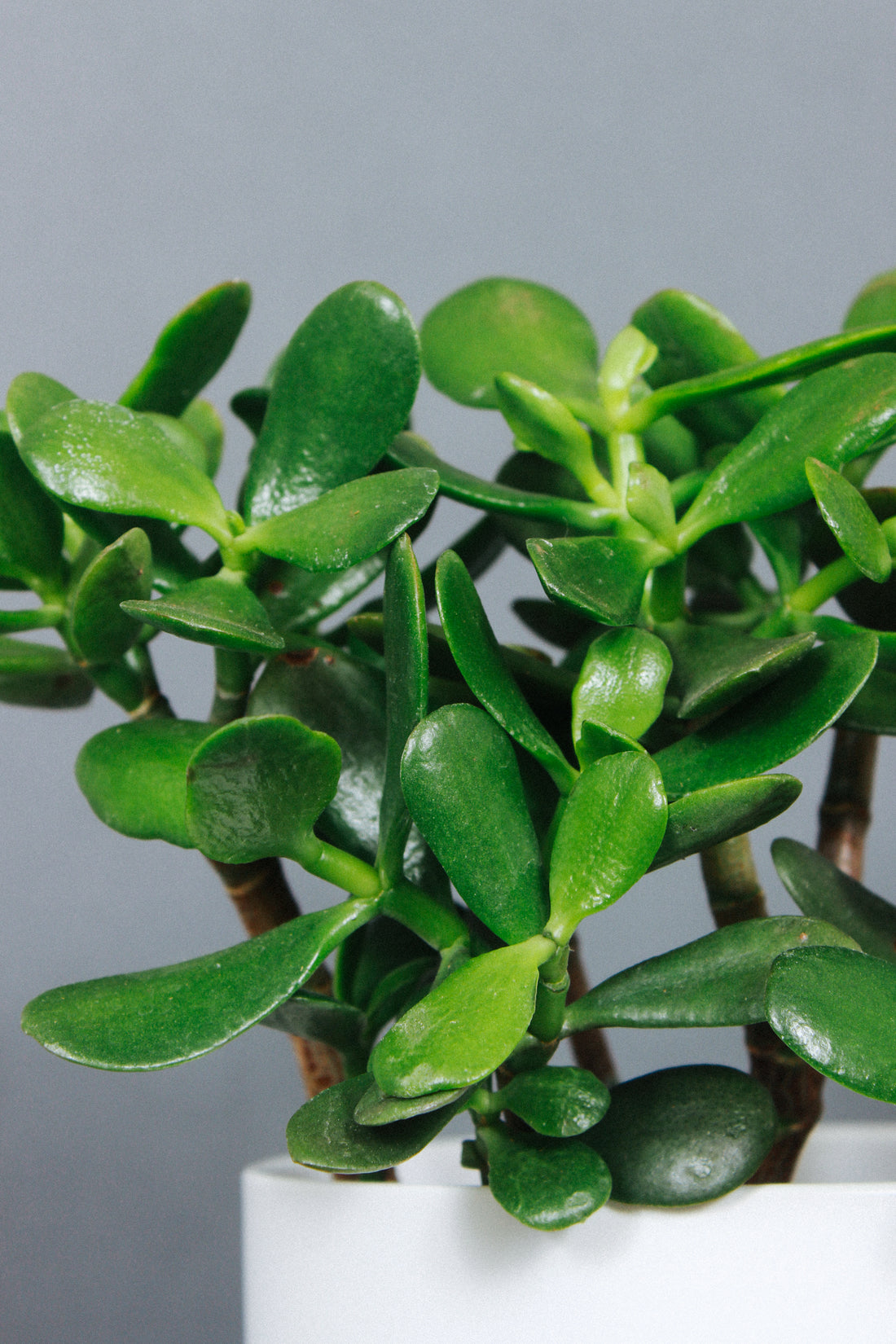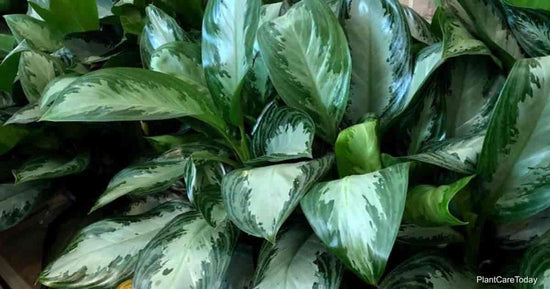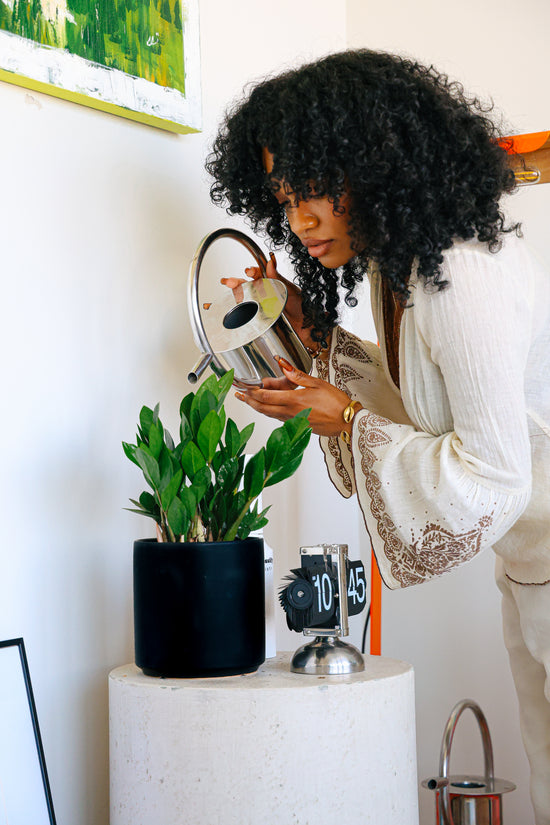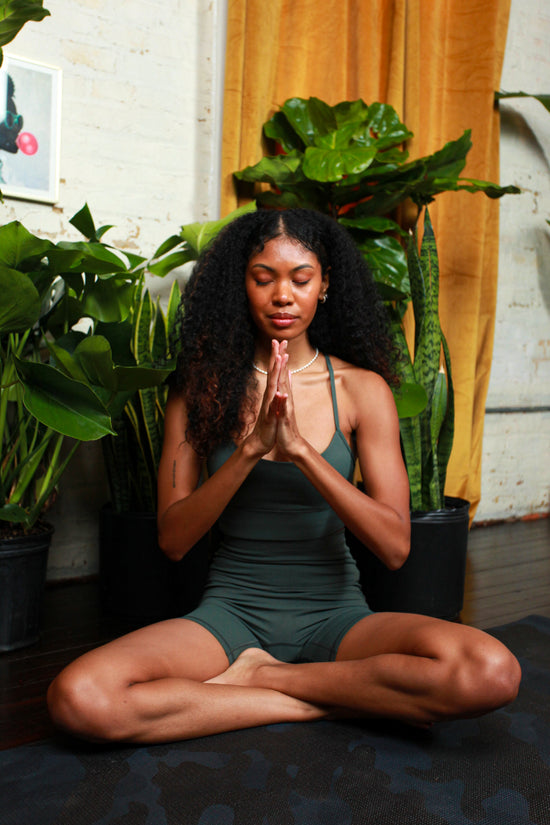The Jade Plant is a fairly easy-to-care-for succulent shrub from South Africa. Plenty of bright light and cautious watering is about all these lucky generational plants need. Here’s the 411 on providing your Jade Plant a long, healthy life.
Maintenance: Intermediate | Climate: Warm + Dry | Light: Bright + Indirect | Watering: Semi-frequent | Pet Safe: No
CHARACTERISTICS
The Jade Plant resembles a miniature shrub with short, thick branches that have many small oval-shaped leaves. The leaves are naturally glossy and deep green, though they can develop a red tinge when exposed to direct sunlight. It can grow up to 6 feet tall indoors and live for many decades.
LIGHT
The Jade Plant comes from very warm and sunny areas of South Africa. To mimic these conditions, place it in bright and indirect light, close to a window that faces South, West, or East.
These plants can tolerate 4-6 hours of direct sunlight once they’re mature but will appreciate partial shade, especially if they are transitioned outdoors.
WATER
Jade Plants are succulents that store water in their leaves. Allow the soil to dry about 75% down in between waterings. They shouldn’t be allowed to go totally dry but rest assured, they’ll survive if you miss watering on occasion.
AIR
A warm and stable spot is ideal for the Jade Plant. Maintain temperatures above 65º and away from sources of humidity, such as humidifiers and bathrooms. They will be happiest placed away from any drafts, vents, and cold windows.
PLACEMENT
Placing a Jade Plant in your home can be a very intentional act when considering their ancient symbolism of prosperity and luck. While meeting their environmental needs, consider also placing them in meaningful areas of your home such as the dining room or workspace.
In Feng Shui, it is also believed that the South-east corner of your home attracts wealth and prosperity. Under bright light, this would be an excellent spot for a Jade Plant.
POTTING & SOIL
Potting and soil are areas that Jade Plants aren’t so forgiving. They prefer to be root bound in small planters so that their small root systems are not overwhelmed. To ensure your Jade Plant isn’t overwatered, keep them in loose, sandy soil and sturdy clay or ceramic planter planters with a drainage hole.
If your planter doesn’t have a drainage hole, you’ll want to add a layer of pebbles to the very bottom of the planter before adding soil. They'll appreciate an annual soil refresh, however, they don’t need much fertilizer and can go years without being repotted.
SEASONAL CARE
During Fall and Winter, Jade Plants will transition into rest and require reduced watering. Remember that they are more likely to survive a skipped watering than one that comes too soon. When in doubt, check the soil moisture with your finger.
It’s important to keep them away from cold windows and drafts. When outdoor climates are suitable, they will enjoy a sunny spot with partial shade.
PRUNING & PROPAGATION
Jade Plants benefit from pruning to maintain a desired shape and size. Pruning will be necessary when a Jade has gained a lot of vertical height and is at risk of tipping over. Removing some top-growth will encourage the plant to grow wider. The healthy pruned pieces can easily be propagated into a young, new plant.
To prune, use clean scissors and cut a stem at its intersection or at soil level. You can also remove a leaf using scissors or your fingers. Lightly tuck the stem or leaf into moist, sandy soil. Over some weeks, roots will form and new growth will sprout from the soil.
COMMON ISSUES
So long as your Jade Plant has bright light and is not overwatered, you shouldn’t see too many issues. Some changes you might encounter are:
RED LEAVES
Red leaf edges on a Jade Plant signal that it is receiving too much direct sun exposure. Move it a few feet away from the window or provide partial shade during the hottest hours of the day.
YELLOW LEAVES
If leaves on your Jade Plant are yellow, the plant is likely overwatered. Check the soil moisture to assess if it is wet or dry. Other signs of overwatering are leaves that are brown, soft, and/or fallen.
WRINKLED LEAVES
Jade Plants store water in their leaves, which gives them a full appearance. When severely dehydrated, the leaves will wrinkle and shrivel. Give it a thorough watering, allowing excess water to flow out of the drainage hole. Discard any remaining water after a few minutes.
SMALL DARK SPOTS
Small dark spots on the leaves of a Jade Plant are commonly from too much moisture. As a result of high humidity, poor drainage, excessive water, or fungus, the best resolution is a dry climate. Damaged leaves can be removed with clean scissors or shears. Any fungus issue should be treated promptly.
BLOOMING
Flowers may bloom on a Jade Plant when it is under unique environmental conditions, such as drought and temperature drops.
PRO TIPS
- Water deeply or bottom-water in a planter with a drainage hole to maintain moisture balance with the Jade Plant. Allow excess water to drain out and discard after a few minutes.
- Include well-draining amendments like sand and coco coir to keep the Jade supremely happy.
Jade Plants are very easy-going. Take proper care of them and these lucky plants can live for a lifetime, being passed down from generation to generation.





